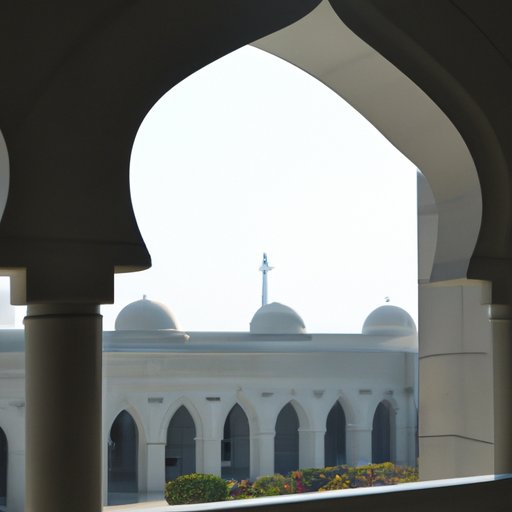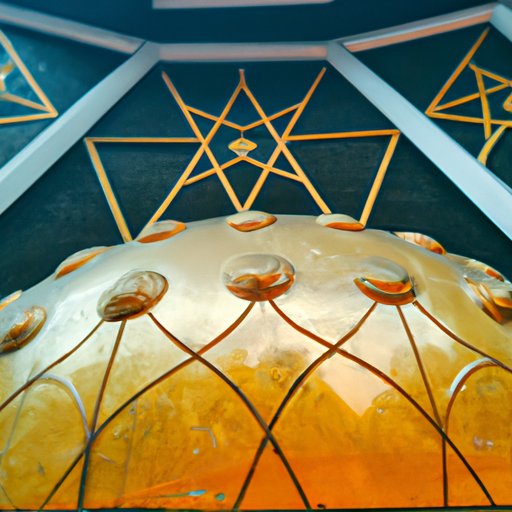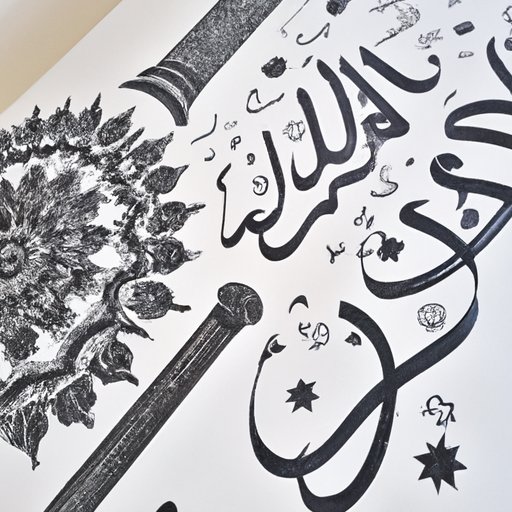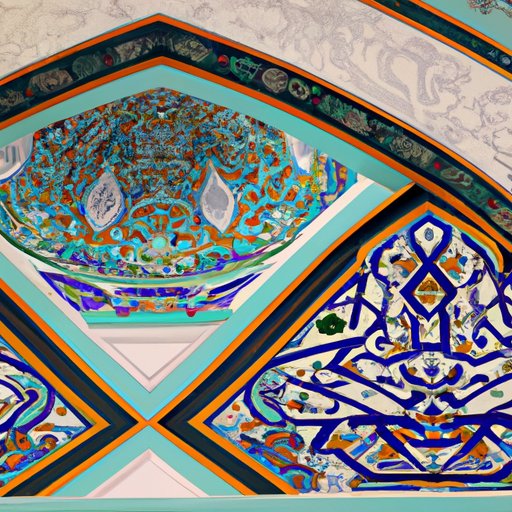Introduction
A mosque is an Islamic house of worship, where Muslims gather to pray, study, and socialize. The architecture of these buildings can vary significantly depending on their location and the era in which they were built. In this article, we’ll be exploring the different architectural features of mosques, both inside and out.
Describing the Different Architectural Elements of a Mosque
When it comes to the exterior design of a mosque, there are some common elements that are often seen. These include minarets, domes, and other external features.
Exterior Design
The most iconic feature of a mosque is usually its minarets, or towers. These typically stand tall above the building and have balconies at the top from which the call to prayer is broadcast. Minarets can be found in various shapes and sizes, depending on the region and style of construction.
Domes are another popular element of mosque architecture. They often sit atop the prayer hall, although there may be multiple domes throughout the building. Again, the shape and size of the dome will depend on the style of the mosque. Other external features can include arches, decorative inscriptions, and elaborate carvings.
Interior Design
Inside the mosque, the main space is the prayer hall. This is typically open and spacious, with a central area for congregational prayers. It may have a raised platform or minbar, which is where the leader stands to deliver sermons.
On one wall of the prayer hall is usually the mihrab, a niche indicating the direction of Mecca. This helps worshippers orient themselves when praying. Some mosques may also have separate areas for women, and additional rooms for studying and socializing.
Other internal features of a mosque can include elaborate decorations, inscriptions, and calligraphy. These are often painted onto walls and ceilings, and can be used to convey religious messages or simply add aesthetic beauty.

Exploring the Architecture of Mosques Around the World
When looking at the architecture of mosques around the world, you can see how different styles and designs have developed over time. For example, in the Middle East, you’ll find mosques with large domes, while in South Asia, many mosques have smaller, more intricate domes. In some regions, such as North Africa, you may even find mosques with no domes at all.
These differences can be attributed to regional influences, such as climate, geography, and culture. In areas with hot climates, for instance, larger domes may be used to help keep the building cool. Similarly, in mountainous regions, mosques may have multiple levels to fit the landscape.

Evaluating the Significance of Dome Shapes in Mosques
The shape of a dome can have a significant impact on the aesthetics of a mosque. Different shapes can evoke different feelings, from grandeur and power to serenity and grace. There is also a symbolic meaning behind certain shapes, such as octagons representing the eight days of creation.
Geometry also plays an important role in mosque design. Many architects use complex geometric patterns to create visually interesting designs. This has become an increasingly popular trend, especially in contemporary mosques.

Investigating the Role of Art and Calligraphy in Mosque Design
Art and calligraphy are two other key elements of mosque design. Decorative elements are often used to adorn walls and ceilings, while inscriptions may be used to convey religious messages. Color can also be used to great effect, either to contrast with the neutral tones of the building or to create a more vibrant atmosphere.
Inscriptions are particularly significant in Islamic architecture. Arabic calligraphy is often used to write passages from the Quran, as well as meaningful sayings and proverbs. This adds a spiritual dimension to the design, as well as making the mosque more visually striking.
Conclusion
As we’ve seen, mosques come in a variety of shapes and sizes, and the architecture of each one is unique. From exterior features like minarets and domes to interior elements such as the mihrab and minbar, there are many elements that contribute to a mosque’s overall design. We’ve also explored the regional influences that shape mosque architecture, as well as the symbolism of different dome shapes and the role of art and calligraphy.
Overall, the architecture of a mosque is an important part of Islamic culture and tradition. From grand, domed structures to more modern, minimalistic designs, there is a vast range of styles to explore. These buildings not only provide a place of worship, but also act as a symbol of faith and community.
(Note: Is this article not meeting your expectations? Do you have knowledge or insights to share? Unlock new opportunities and expand your reach by joining our authors team. Click Registration to join us and share your expertise with our readers.)
